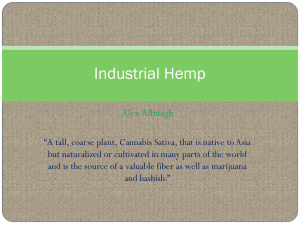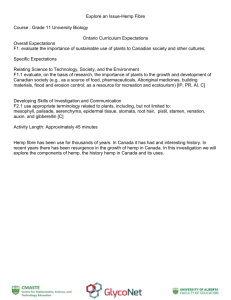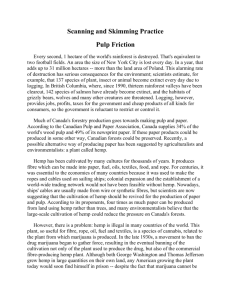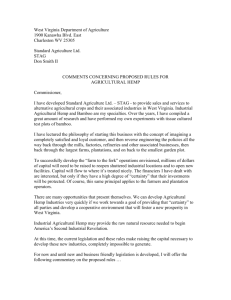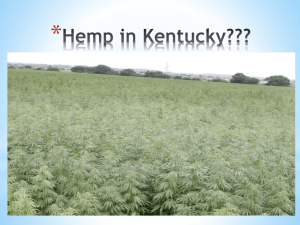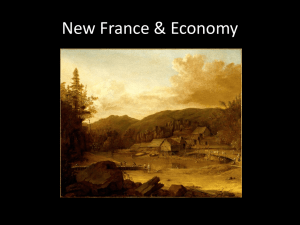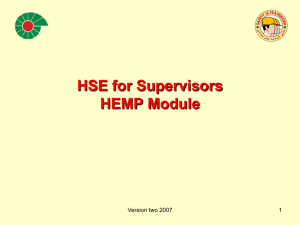HEMP INNOVATION 2015 - Canadian Hemp Trade Alliance
advertisement
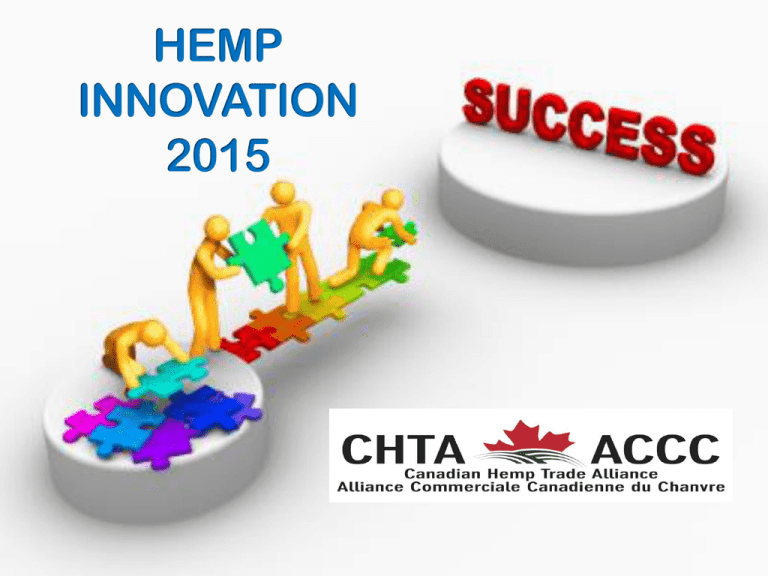
LONG-TERM INTERNATIONAL STRATEGY (LTIS) Prepared by Russ Crawford and Markus Schmulgen It is the goal of the industry to grow 40,000 hectares (100,000 acres) of hemp in Canada by 2015. Given average yields and current prices, this represents over $35 million in farm gate receipts which translates into over $100 million for the Canadian economy. The various goals of the LTIS will support… ---Hemp 2015-$100 million--- 1. Background 2. SWOT 3. Branding 4. Strategy 5. Strategy Formulation 6. Strategy Implementation 7. Measurement National Industrial Hemp Strategy Evolution of CHTA and Board Executive Director & Board Membership – producers, companies, etc. Funding – Industry, government Industry Standards - By-laws, Code of Conduct Support from AAFC & CAAP LTIS Review Promotion and Communications Research Market Development Administration Current state of the hemp industry in Canada Expanding acres in Canada Controlled and monitored by Health Canada Remains illegal to grow in USA International market focus on fibre More hemp SKU’s in N. America Economics still show hemp is highly profitable Environmentally friendly & non GMO Yukon 60,000 50,000 40,000 PEI NS NB 30,000 20,000 10,000 0 Quebec Ontario YEAR 20 08 20 06 20 04 20 02 Man. 20 00 19 98 Acres Hemp Production in Canada Sask. Alberta BC Canadian Hemp Product Exports $12,000,000 $10,000,000 $8,000,000 Hemp Oilcake $6,000,000 Hemp Fiber $4,000,000 Hemp Oil $2,000,000 Hemp Seed $0 2006 2007 2008 YEAR 2009 2010 Proj. Ambitious Goals?...........Not Really………….. Economic Benefit Acres 80,000,000 $200,000,000,000 70,000,000 $180,000,000,000 60,000,000 $160,000,000,000 $140,000,000,000 50,000,000 $120,000,000,000 40,000,000 acres $100,000,000,000 $80,000,000,000 30,000,000 $60,000,000,000 $40,000,000,000 20,000,000 $20,000,000,000 10,000,000 $- hemp canola soybeans eco benefit Themes from ANUGA 2011 LOHAS – lifestyles of health and sustainability. Convenient, gluten & allergen free. People spending more to regain health. People taking responsibility. Organic consumption growth rate is 20%/yr. Awareness of challenges with GMO. Animal products tainted – mad cow, radiation, meds, hormones, poor land use, subsidies. Evolution to vegetarian and vegan diets. WHAT 100,000 acres $100 million WHEN By 2015 HOW Communication Research Market Development Administration Specific Action Plans Create and execute a brand and communications strategy. Research health benefits and feed applications. Secure GRAS status for hemp powder and oil. Operate a full time industry association office. Promotion and Communications Develop and implement a two-year branding and communications strategy for hemp and hemp products targeted at export destinations. Research - Conduct research on health benefits and feed applications for hemp products achieving results from at least one study each year for the next two years for a total cost of $1,000,000 over the full time period. Market Development - Secure GRAS status for hemp protein powder and hemp oil over the next two years at an annual cost of $1,000,000 per year. ($2,000,000 in total). Administration - Operate a full time CHTA executive office out of Winnipeg with an Executive Director and communications employee responsible for day-to-day operations and market development execution at a cost of $100,000 per year. Objectives that will benefit the whole industry… 1. To undertake the research necessary to promote and obtain regulatory approval for hemp as a healthy ingredient. 2. To facilitate the effective use of generic market development and promotion programs by CHTA members that are targeted and geared towards developing new opportunities. 3. To expand/find new uses or dual usage for hemp (seed, for food and cosmetics, and fibre) Effects of Hemp in Poultry Rations. Effects of Hemp Protein and BioActive Peptides on Hypertension and Kidney and Heart Health. The Safetiness and Bio Availability of a Long Term Consumption of Hemp Oil in Vivo. Hemp Decortication and Use of Decortication By-Products for Biofuel Production and Green Building. 1. Background 2. SWOT 3. Branding 4. Strategy 5. Strategy Formulation 6. Strategy Implementation 7. Measurement • Producer of high quality hemp seed and fibre. • Focused, capable dedicated group of members of CHTA. • Development of a prioritization of projects based on industry demand and growth signals. • Body of knowledge with respect to breeding, processing and product development. • Name recognition – Hemp – Canada. (More for food than fibre). • Established relationships with retailers and end user clients – product awareness. • Many Canadian co-operative ventures assuring ongoing participation from vested stakeholders along the supply chain. • Engaged government supportive in developing the crop sector. • The need to achieve Generally Recognized As Safe (GRAS) status with the US Food & Drug Administration for hempseed and hemp products. • Lack of approval from the Canadian Food Inspection Agency (CFIA) for the use of hemp and hemp products in animal feed. • Lack of clinical research specifically on the health benefits of hemp seed and oil. • Absence of funds to proceed with critical clinical trials and hemp product efficacy. • Government’s 50/50 matching strategy poses significant problems in qualifying for any funding programs. • Small producer and processor base unable to source adequate funding to conduct necessary research. • Absence of hemp fibre processing facilities in Canada. • Consumer demand is trending more towards local, natural, organic, eco-friendly products playing right into the primary attributes of hemp food and fibre products. o Human foods o Pet foods o Body care products o Health industry o Building products • Build on the positive environmental impact of hemp in the agricultural sector as a minimal user of chemicals producing a non-GMO product. • Work with government financial support and people resources to develop new products and identify and capture new markets. • Continue the work on clinical trials, feeding trials and varietal development building on our existing experiential knowledge and expertise. • Work together as an industry for the strategic advantage of the Canadian hemp trade. • Inability of the CHTA to sustain operations due to inadequate funding. This would result in the loss of a focal point and primary contact for programs and direction. • Concentration of dedicated industry participants may exhaust the energy and commitment of those people. • USA legislation approving the cultivation of hemp (this may be seen as an opportunity, as it potentially accelerates the development process and research requirements with new investors, but it has the potential to marginalize the Canadian hemp industry). • Potential for either demand or supply to outpace the other creating a market failure. • Shortage of available, affordable sample testing laboratories. 1. Background 2. SWOT 3. Branding 4. Strategy 5. Strategy Formulation 6. Strategy Implementation 7. Measurement Brand Hemp as “Canadian” Quality Leverage our production experience and ideal agronomic conditions. Establish and build on the idea that Canadian hemp is superior to hemp grown elsewhere in the world. Product recognition and brand identity. 1. Background 2. SWOT 3. Branding 4. Strategy 5. Strategy Formulation 6. Strategy Implementation 7. Measurement Positioning the industry relative to competition that is well established. Developing a shared vision. Uniting stakeholders to work together. The hemp industry is at a critical “Grow or Die” stage. Know Yourself Research Clinical trials Know Your Customer Nutritional benefits Education Discover factual attributes of the properties, characteristics and functional value of the hemp plant in order to make substantiated claims. Seek out the needs and preferences consumers are looking for in food and fibre products. Communicate, in an effective manner, how well hemp can satisfy these specified needs. Processed Canadian hemp products, in one form or another, have found their way to 30 different countries around the world over the past four years. 1. Background 2. SWOT 3. Branding 4. Strategy 5. Strategy Formulation 6. Strategy Implementation 7. Measurement Promotion and Communication Two year branding and communication Research Two year $2,000,000 Market Development GRAS - $2,000,000 Administration $100,000 Annually Completion of Marketing Materials Hemp 101 Overview Trade Show Booth Trade Show Banners Social Media Campaign Important Events Hemp History Week Natural Products Expo East, USA Natural Products Expo West, USA American Dietetic Association, USA Green Festival-San Fran, NYC, LA EIHA-May 2011 Culinary Institute of America, USA Canadian Health Food Association Trade Show, Canada Natural and Organic Product Expo Europe 3, Great Britain BioFach, Germany ANUGA, Germany Failure to maintain an industry association to lead the initiatives identified through: Inadequate funding. Lack of industry support and co-operation. Reduction in the profitability of growing and/or processing hemp for food and fibre applications vs. competing crops. Public and governmental stigma towards hemp. Cost of Production dual purpose crop agronomic research Product Innovation Infancy Industry stage…niche market Stigma of hemp/marijuana “Refer Madness” growing acceptance with education - 14 years in the making. Illegal to grow in USA, DEA lost in court 2003-4, border is open, many states passed to grow. Hemp milk & ice cream on Dr Oz April 2011. Soy, corn & rice functional food competition. Execute LTIS Strategy. Secure funding to support research, communication strategies and ongoing administrative support. Embolden and entrench CHTA as unifying voice for the Canadian hemp industry. Build North American/ European Collaborative Ventures. Eradicate Stigma.

